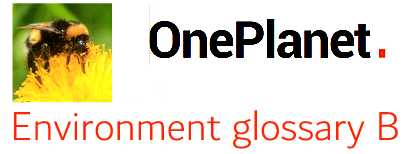OnePlanet is for people who speak English as a second or third language
A B C D E F G H I J K L M N O P Q R S T U V W X Y Z CLICK for list of all the words
B is for: |
: |
a backswimmerThe backswimmer or water boatman (Notonecta glauca) is an insect that lives in fresh water, especially in ponds, and eats small invertebrates. In other words, it's a carnivore, a predator. It can swim anywhere underwater, but it us usually just under the surface. It's called a "backswimmer" because it swims on its back; and a "water boatman" because it moves around with one long pair of legs that look like the oars of a little boat. Notonecta images by Julie Gallagher, Creative Commons BY 2.0, and fuentedelateja, Creative Commons BY-SA 2.0 |
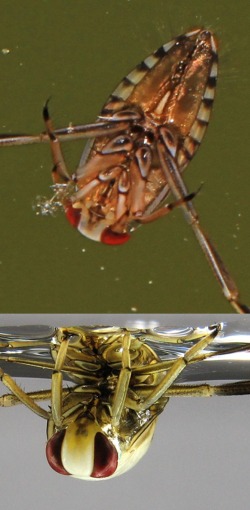 |
barkBark is the skin of a tree or a shrub. (A shrub is either a bush - see Bush, below - or a very small tree.) You can identify most trees by their bark, as well as by their leaves, flowers, fruit, location and general shape. That makes it possible to identify a deciduous tree in winter, when it has no leaves. A lot of trees have very characteristic bark. The bark of the London plane (Platanus x hispanica) has a unique colour, texture and shape. So does the giant redwood (Sequoiadendron giganteum). The sweet chestnut tree (Castanea sativa) has bark with deep vertical grooves, and the grooves are usually in a spiral for the bottom 2 metres of the tree - see the photos. Sweet chestnut tree images by Wendy Cutler, Creative Commons BY 2.0, and Brian Toward, public domain. |
 |
a beeThere are more than 20,000 species of bee in the world, with about 260 species in Britain. Surveys have found as many as 50 different species in a single London park. Bees can be very big; Wallace's giant bee (Megachile pluto from Indonesia) can be 40mm long, which is about as big as your thumb. They can also be very small. Four little sweat bees (Halictidae) became international celebrities in 2019 when a hospital in Taiwan removed them from a woman's eye. They had been under her eyelids for at least 24 hours, drinking her tear fluid, and they were still alive. When I think about bees, the first picture in my mind is a big, round, furry insect with black and orange stripes, that flies slowly and makes a loud buzzing noise. That's a bumblebee - see the photo. Honey bees are smaller, faster, less furry, and have black and amber stripes. They live in communities of thousands of bees. Most species of bee are solitary; they live alone. Solitary bees often make holes in the ground to live in. It's easy to see these holes in any area of short grass like a park or garden. Some bees are "solitary" because they like to live in individual holes, but they still like to live next to others, so you might see 40 or 50 little holes in the same bit of ground. Britain's largest bee is the buff-tailed bumblebee (Bombus terrestris, often 17mm long). The smallest UK species is the Small Scissor-Bee (Chelostoma campanularum, often only 4mm long). The males of this species sleep inside flowers. How cute is that... Not all bees produce honey, and only a few species live in large groups and produce enough honey to interest humans. However, bees are vital to gardeners, farmers and in fact to human life on this planet, because they are pollinators. They move pollen from one flower to another, and this gives us fruit and vegetables. And more flowers. Bumblebee image by Daniela, Creative Commons BY-SA 2.0. |
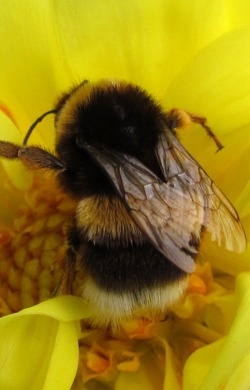 |
a berryIn everyday English, a berry is any small soft fruit that doesn't have a stone like a cherry. When we think of "berries", we think of the blueberry/bilberry, cranberry, gooseberry, redcurrant, blackcurrant, raspberry, strawberry or blackberry. A lot berries are edible, but some nice-looking berries are poisonous, for example those of Atropa belladonna or deadly nightshade. If you're a botanist, part of your job is to classify plants logically, according to their development and structure. If you look at the first five berries we've mentioned (blueberry/bilberry, cranberry, gooseberry, redcurrant and blackcurrant) you'll see they are simple globes - even though the gooseberry is a strange hairy thing that looks like a small kiwifruit. They are true botanical berries. However, if you look at the photo you'll see that a raspberry is made up of about a hundred little "drupelets", and a strawberry is something else again. The botanical definition of a berry is a fruit that starts off as a flower with a single ovary; it has two or more seeds (so a cherry isn't a berry, because it only has one seed); and it has a skin (exocarp), a soft juicy layer (mesocarp) and a central area with seeds (endocarp). That means grapes, tomatoes and even pomegranates, bananas and watermelons are also technically "berries"! Berry images by Ole Husby (bilberry), Creative Commons BY-SA 2.0; Ben Stephenson (raspberry), Creative Commons BY-SA 2.0; Richard Lewis (strawberry), Creative Commons BY-SA 2.0 |
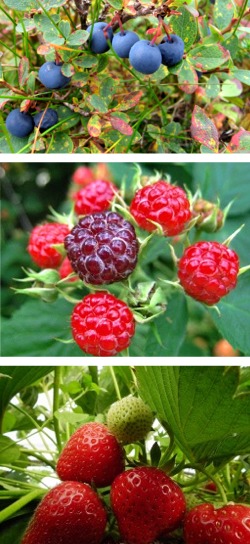 |
biodiversityBio- means "life", and biodiversity is "biological diversity". In other words every living thing in the world. Some people call it "natural diversity" or "natural heritage". Biodiversity has three levels. It's about all those different habitats, and all those different species, and the genetic differences within a species. It's the differences that are important. Why is biodiversity a good thing? Why do we need it? Different species of plant and animal do different jobs. If you reduce biodiversity so that essential jobs are done by only a few species, it's like a business in which only one or two people know how to operate an essential machine. Sooner or later, those people will be absent (illness, accident, death) and then your business stops. There are four main reasons why we need biodiversity: 1) Biodiversity as part of a system. We need all kinds of life to keep us alive. Humans can't turn carbon, water and sunlight into food and oxygen but plants can do this by "photosynthesis", so we need green plants. Plants need a community of bacteria, fungi, insects and worms. These things may not be pretty, but they do things we can't do. They turn dead plants and animals into new life; they make the soil fertile; and most plants need them to reproduce and to grow properly. Wild animals need biodiversity so that they can find something to eat at all times of the year. And biodiversity is not just about life on land. We also need the sea and its living organisms. A lot of us get most of our protein from fish, but the sea does more important things than give us a tuna salad. Plants in the sea produce most of the oxygen we breathe, and the oceans are a system that keeps the temperature and humidity of Planet Earth in the small range we can live with. You can't just kill the parts of nature and the environment that you don't much like, because they're all part of one system or another. A forest is not just trees; the trees rely on a complex system of mycorrhizal fungi and bacteria, and on a balance of other living organisms that turn rock and dead plants into something the trees can use. Soil for farming also depends on biodiversity. All the things that live in the soil (worms, bacteria, fungi, etc) keep it fertile, well drained and aerated. They're a community. We can put in artificial fertiliser made using oil, but producing fertiliser is a major cause of global warming, fertiliser run-off causes problems for rivers and lakes ("eutrophication"), and the oil isn't going to last forever. Worms, bacteria and fungi will last forever, if we're careful not to kill them. 2) Biodiversity to survive change. The more biodiversity you have - the more different species there are, and the more genetic variation within species - the more species will survive changes. For example, trees and climate change. If the climate in your country gets hotter and drier (or colder and wetter) it's good to have 20 different kinds of tree, because 8 or 10 or 12 of them may be happy in the new climate. If you only have 2 kinds of tree and the climate changes, you may finish with ... 0 kinds of tree. It's the same with disease. If you have 10 similar species or sub-species of plant (or bird, or animal) and there is a serious disease, it may kill 3 of them, or 6 of them, but it won't kill all 10. There are always changes in nature. Diseases and parasites change all the time, and move to new places, as they look for new ways to attack. Ships bring animals and diseases from the other side of the world. The chemistry of lakes and rivers changes because of industry and farming. Farmers, gardeners and tourists transport parasites and diseases all over a continent in a few years, or sometimes in a few weeks, so other plants and animals don't have time to adapt. For example, Chytridiomycosis is a fungal disease from Australia which kills amphibians such as frogs. Tourists (and amphibian biologists...) have spread it over half the world in 25 years. It kills 100% of some populations of frogs, but in other populations it only kills a few. The more change you have, the more biodiversity you need. What if you're a farmer and you think, "This one variety of this species is the perfect; We'll just use this one and all the others can die if they want to"? You could soon be in big trouble. This is what caused the 1845 Potato Famine in Ireland. There were lots of wild potatoes in Peru. Some were strange colours, some were very small, most were odd shapes, some needed more heat or less water. Only one kind of large, white potato got to Ireland. A single disease called Phytophthora infestans killed them all in just 2 or 3 years. The disease was bad; overpopulation and government policy made it a human disaster. In 1863, an American aphid called Phylloxera vastrix attacked grape vines in France. In just 12 years, it killed 90% of them. There was no way to protect the vines or to kill the insect. However, American grape vines were slightly different - diverse - and they had a natural resistance to this insect. Grape farmers in France replaced their grape vines with American vines. Today nearly all domestic bananas are genetically identical, which means they could easily be destroyed by a small change in some parasite or disease. The loss of bananas would be a catastrophe for the countries where they grow, which are often poor. A new disease of wheat could be a catastrophe for all humans, not just for the poor. Non-wheat alternatives such as spelt, farro and quinoa are important because they're different. Because we're making big changes to natural environments, including climate change, we really need flexible food production. When you don't know what the future holds, it's important to have the largest possible number of different (diverse) species, especially of food plants and insects to pollinate those plants. 3) Biodiversity and useful species. We only know a few hundred species of plant, fungus and animal really well. There are certainly species we don't yet know that could be as useful as the willow tree (aspirin), the foxglove (digitalis), the opium poppy (morphine), the yew tree (paclitaxel or taxol), the cinchona tree (quinine), Rauvolfia serpentina (reserpine), the poison arrow frog (medical curare), the silkworm (silk) and so on. Also, wild relatives of potatoes, wheat, rice, bananas, apples and so on that can be used to diversify and improve farm varieties. 4) Biodiversity has value. Nature has an inherent value (if you like it) and a dollar value (if you don't much like it). For many of us, it's obvious that we need all the biodiversity we can have, just because it's life. Trees and birds make it a pleasure to be alive and human. Nature makes a walk in the countryside a great thing to do. We like to get away from it all, to escape the rat race, to go somewhere unspoiled. But what if you prefer a nice hotel with a golf course and a town with great shops and restaurants? Maybe you even get a little angry when you hear the words "biodiversity", "ecology", "environmental" and "community"? But you feel good when you hear the words "productivity", "economic growth", "wealth" and "high net worth"? There is something very attractive about cutting down a forest to make a million dollars, or filling in a marsh to build a new hotel. That's where the concept of ecosystem services or ecological services comes in, by showing that nature has a dollar value. The big problem for biodiversity on Planet Earth is us. It's partly the number of humans now on the planet, and partly the things that we want - cars, plastics, fashion. If you destroy the habitat of a species, you destroy the species. The fastest way to destroy a habitat is with pesticides. The second fastest is by clearing land for farming or to build homes, or by clearcut forestry to provide jobs. And then there's climate change, which is slower and less obvious but a much bigger problem. Don't believe Jurassic Park; when a species is gone, it's gone. | 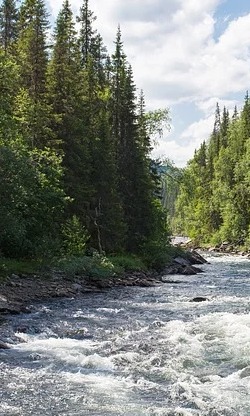 |
a bird of prey, or raptor"Prey" means animals that are killed and eaten by other animals. The words "prey" and "predator" are connected. Lots of birds kills and eat other animals. Penguins, herons and shrikes kill and eat. Most garden birds kill and eat insects and worms, and even a chicken will kill and eat a mouse if it can, but none of them are "birds of prey" or "raptors". Birds of prey have long, sharp talons on their feet. They also have sharp, hooked beaks for eating meat, but it's the feet that are really important. Click on the osprey image to see talons and a hooked beak. Falcons, hawks, kites, harriers, buzzards, ospreys and eagles are definitely birds of prey. Does the definition include vultures and owls? Some experts say yes, some say no. Hawks, falcons and owls kill prey animals to eat. They're predators. Eagles are predators, but they also eat animals that are already dead ("carrion"). That's called "scavenging". Click here for an article about the white-tailed eagle. Vultures are mainly scavengers that eat carrion, but they will sometimes kill prey animals. Osprey image by Skeeze on Pixabay. |
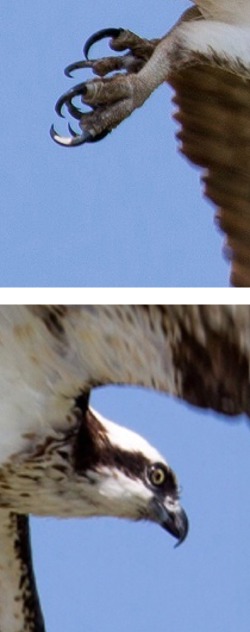 |
a black locustThere are insects called locusts, but this locust is a kind of tree. It's also called robinia or false acacia, after its Latin name Robinia pseudoacacia. Until 1636 this tree lived only in the Appalachian and Ozark mountains of America, but then young trees were taken to Europe for gardens and parks. Locust wood is useful because it's strong and it's very durable; in other words, it lasts a long time, even in repeated wet-dry conditions. That makes it good for fences, houses and boats. In Britain, robinia is a "non-native species", but it's not an "invasive species" because it's not a problem here. My mother has one in her garden, and it looks very nice in spring with all its flowers. This species is invasive in many parts of the world, because it's very good at turning open grassland into woodland. It's a criminal offence to plant it in some US states. |
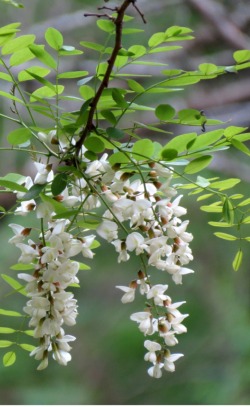 |
a blackbirdThe blackbird (Turdus merula) is a common bird in parks and gardens everywhere in Europe except for northern Scandinavia. They often visit garden bird tables, and they have a very nice song. The blackbird is a medium-sized bird, one of the thrush family. The male is black all over, with a yellow bill. The female is brown like most thrushes. Male blackbirds are strongly territorial. In other words, they don't like to have other male blackbirds in their territory. Image by Hedera.baltica, Creative Commons BY 2.0 |
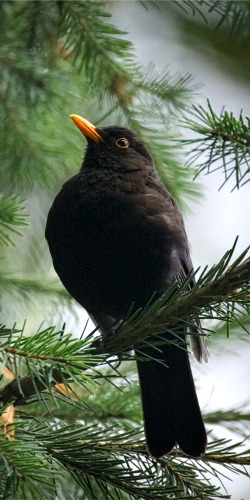 |
blackthornBlackthorn (Prunus spinosa) is a shrub. A shrub is is a woody plant that can either be a bush or grow into a small tree. Blackthorn grows everywhere in Europe. It's a very useful plant for farm hedges, because it has a lot of sharp thorns. A hedge is a barrier, typically about 1.5 metres tall, made of tree and shrub species. Until very recently, every field on every farm had a hedge around it, or at least a stone wall. Because of the sharp thorns, even cows don't try to get through a blackthorn hedge. Blackthorn is a member of the Prunus family which includes fruit trees such as cherries, plums, apricots and peaches. Like them, it has lots of flowers in spring, and the fruit looks like a small plum. The fruit is called a sloe, and it's famous for being very sour (the opposite of sweet). Sloes are ripe in late September, and they're used for making sloe gin. Unfortunately you have to buy the gin; the sloes are just for flavouring. Buy a 1-litre bottle of gin. Take 0.5 litres of gin, 225 g of fresh sloes and 100 g of sugar. With a sharp knife, make several small cuts in the skin of each sloe. Then put all the ingredients in a clean glass container (such as your 1-litre gin bottle). Add more gin to fill the bottle to the top, and put in a cool, dark place for two or three months. Once a week, shake the bottle. Take a small flask of sloe gin when you go on country walks in winter. Images: Blackthorn at Portscatho by Tim Green, Creative Commons BY 2.0, Sloes by Giles Watson, Creative Commons BY-SA 2.0. |
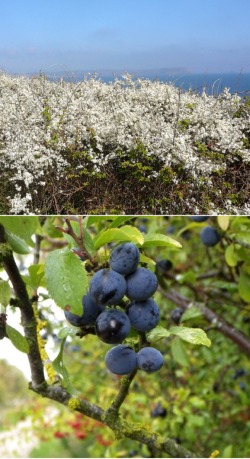 |
blackwater"Blackwater" is an engineer's name for sewage*, which is the solid and liquid human waste that we put down our lavatories. "Greywater" is the engineer's name for dirty water from baths, showers and kitchen sinks. Blackwater is a problem for several reasons. The main problem is not the bad smell but the bacteria, viruses, fungi and parasites it contains, because these can survive and infect other people or animals. Even marine mammals like seals and dolphins can catch infections from untreated blackwater. The other big problem is the oxygen that blackwater takes from any river or lake it enters. Billions of bacteria in the solid waste are working to decompose it, and they need a lot of oxygen. If blackwater enters a river, the fish may die from lack of oxygen. Blackwater is usually processed in an industrial sewage treatment plant, but it is also possible to use reedbeds. Click here for more about reedbed sewage treatment. *The word "blackwater" is also sometimes used about any dead organic matter that suddenly enters a river or lake, for example when there is a lot of rain in a dry country such as Australia. Images by SuSanA Secretariat, Creative Commons BY 2.0 |
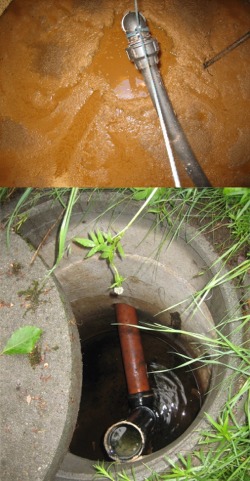 |
blossomThe flowers on a fruit tree. See There's Something About Blossom. Image by Clare Black, Creative Commons BY 2.0. |
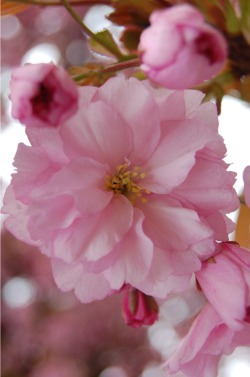 |
brackishFresh water has little or no salt. Sea water is about 3.5% salt. Between fresh water and sea water there is brackish water, withbetween 0.5% and 3% salt. Some species of plant and animal can only live in sea water, some can only live in fresh water, and a few can only live in brackish water. If you want to find brackish water, the first place to look is in an estuary. That's the mouth of a river, where it goes into the sea and fresh water mixes with salt water. They don't mix instantly. Salt water is denser than fresh water, so the fresh water floats on top of it, almost like oil floating on water. It can be a long time before they are fully mixed. If they meet in a quiet place with good underwater lighting, you can often see interesting optical effects caused by this. Image by Paulo Valdivieso, Creative Commons BY-SA 2.0. |
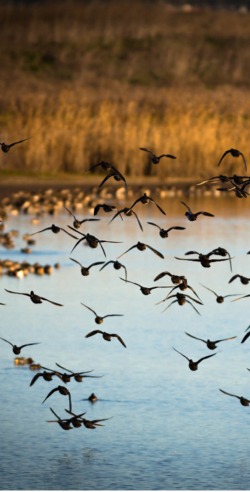 |
brambleThere are wild and domesticated plants in the Rubus family all over the world. They produce sweet fruit including raspberries and blackberries. Brambles, Rubus fruticosus, grow wild and produce lots of blackberries. In September you can often find ripe blackberries right next to ripe apples, which is perfect for Britain's favourite home-made dessert, apple & blackerry pie. Brambles grow everywhere in Europe, especially in hedges and as an understorey in woodland. They give dormice and many other animals a safe place to live because they make thick bushes with lots of sharp prickles, almost like roses If you have brambles in your garden, they can make a lot of work because they spread quickly and they can soon cover an area of land with vegetation 1 metre deep. They aren't easy to get rid of, and you have to wear strong leather gloves. If you cut them down to ground level, they soon grow back. It's best to wait for wet weather when the ground is soft, and pull them slowly out of the ground. If you pull them fast, they'll break, but if you pull very slowly, the roots will come out of the ground. Brambles image by Rob Mitchell, Creative Commons BY-SA 2.0 and blackberries by Rob on flickr, public domain. |
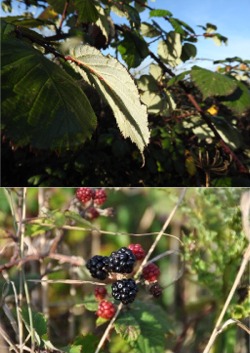 |
a breedWe talk about different species and subspecies of plant and animal; different races of humans such as caucasoid and mongoloid; and different breeds of domesticated animals such as Labrador dogs and Arabian horses, British Longhorn cattle and Hebridean sheep. For domesticated fruits, vegetables and flowers, we usually talk about varieties or cultivars, not breeds. A breed is the result of selective breeding by humans who wanted particular characteristics for a domestic animal. In other words, humans see a cow that gives excellent milk, or a sheep that gives excellent wool, and they try to get more of these good animals by choosing which male and female can reproduce together. Humans started to domesticate plants and animals ten thousand years ago, or fifteen thousand years ago for the dog. In some cases, the original wild plant or wild animal no longer exists, but many "rare breeds" are similar to these original wild ones. They're no longer popular for commercial farming, because there are new breeds of cow with even more milk, or sheep with even more wool. However, it is very important to keep rare breeds. Their genetic diversity means they often have characteristics that new breeds don't have. It often happens that farmers all over the world start to use just one or two breeds or cultivars. If all the bananas in the world's supermarkets are genetically identical, a single disease or a small climate change could destroy every commercial banana plant, all over the world, in just a year or two. We have already had a big problem with potatoes (the European potato famine, 1845-1852), and with grapes (the European Phylloxera plague, 1870-1890); and we may soon have a big problem with bananas. Fortunately, there are about ten farms in Britain that welcome visitors who want to see Gloucester Old Spot pigs, Clydesdale horses and other rare breeds; and there are national and international organisations that keep rare cultivars of apples, potatoes, and so on. It's all good for biodiversity. Images: Longhorn bull by Karen Roe, Creative Commons BY 2.0 and Hebridean sheep by David Wright, Creative Commons BY 2.0 |
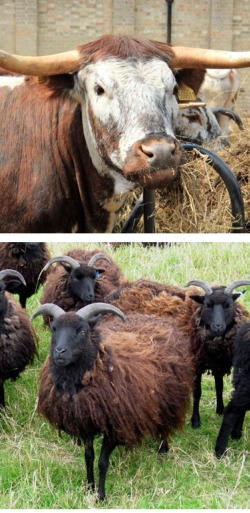 |
to breedBreeding is animal reproduction - making babies. (Specifically, it is sexual reproduction. There is also asexual reproduction, in which a single animal can produce new animals without sex.) How do you use the verb "to breed"? First, you can say "swallows return to Europe to breed in summer", or "the wildlife park's two young lions bred successfully in 2019". Or, if breeding is the result of a decision by a farmer or a zoo, you can say "18th century farmers bred pigs to be as fat as possible" or "very few zoos have successfully bred the UK native seahorse Hippocampus hippocampus" Lambs image by Aaron H Warren, Creative Commons BY-ND 2.0. |
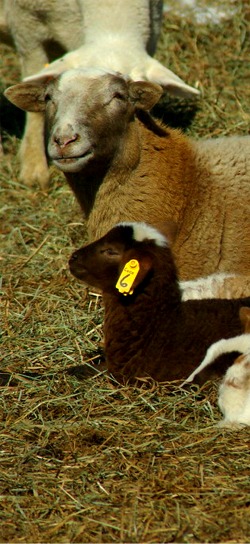 |
to brood, a broodThis word relates to eggs. "Brooding" is when a parent animal stays very close to its eggs, so as to protect them. A snake or fish "broods" its eggs to protect them from predators. Some fish "mouthbrood" to protect their eggs. For some time after they hatch, the baby fish stay close to the parent and quickly go into the parent's mouth for protection from predators. Some adult fish, amphibians and invertebrates have a "brood pouch" which is a body cavity that eggs and small babies can stay in for protection. A bird broods its eggs partly to protect them from predators and partly to keep them warm (incubation). It does this by sitting on them. An adult bird with eggs may have a "brood patch", which is an area of bare skin on the abdomen. This gives direct contact between the eggs and the parent's skin, which helps keep the embryos warm and hydrated. You can say that a hen is "broody" when it's only interested in making a nest and getting some eggs to sit on. "A brood" is one set of babies for one pair of birds. For example, "barn owls have only one brood per year". By extension, you can say that a person is "brooding" if they look unfriendly and seem to be thinking about a problem. Or thinking that you're a problem. For example, in the BBC series of Jane Austen's novel Pride & Prejudice, Colin Firth played the Darcy character as a "brooding romantic hero". I will never understand why women like "brooding" men. Colin Firth says he played Darcy as somebody "completely and utterly dislikeable, unsympathetic, judgemental and snobbish", and even he doesn't understand why women like Darcy. See also Daniel Craig's James Bond, Jon Snow in Game of Thrones, and every male vampire ever. You can even say that a landscape is "brooding" if it is dark, still and unfriendly. Try a Google image search on "brooding". Image of mother and baby coot (Fulica atra) by Graeme Anderson, Creative Commons BY 2.0 and of Daniel Craig as James Bond by Luke Rauscher, Creative Commons BY 2.0. |
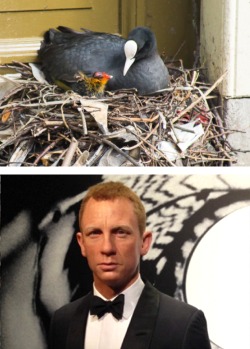 |
a bushA bush is like a small tree with no trunk. You can climb a tree, but you can't climb a bush. It's too small and its branches are too thin, so they're not strong enough to stand on. The branches are also too close together for a person to climb. A bush is usually some species of shrub, and a shrub is any species of plant with woody tissue that is usually a bush. (I think that's what they call a "circular definition"...). However, a shrub can get quite big if it has ideal living conditions. It can even become a small tree, big enough for a child to climb. Bushes and trees both make hard, strong, woody tissue. However, the typical tree has a single trunk like a column, with a lot of branches on top of that. A bush just has the branches and no trunk. If somebody has a big, dense beard or eyebrows, you can say these are "bushy"; and if an animal or person looks very healthy and happy, you can say it looks "bright-eyed and bushy-tailed". The squirrel is famous for having a bushy tail. Image by Nicholas of OnePlanet and Linguetic, Creative Commons BY 2.0. |
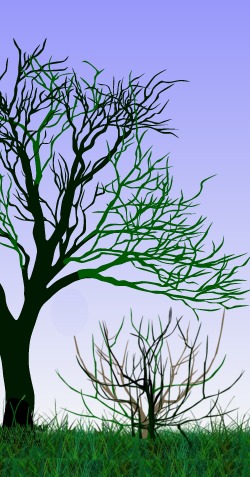 |
a butterflyIn ordinary English, the Lepidoptera are divided into butterflies (which are insects that fly during the day and have big colourful wings) and moths (which fly at night and are usually brown). It's true that most moths are nocturnal and brown, but there are also plenty of moths which are active during the day, and some of them are quite colourful. There are also plenty of brown butterflies, but I don't know of any nocturnal butterflies. The scientific difference between butterflies and moths is their antennae. A butterfly's antennae are "clubbed", which means they end with a slightly thicker part. A moth's antenna are either a simple-looking filament with no club, or a very complex shape like a feather. Nobody knows where the word "butterfly" comes from. There is a nice (but wrong) idea that it started as "flutter by". If you take a piece of paper and hold it in a strong wind, it will flutter. "Flutter" is exactly how butterflies fly. They flutter from one place to another. Moths are famous for coming to artificial light at night, even if it kills them. There's an expression "like a moth to a candle flame" which is used about people who behave like that, often because they're in love with somebody who's bad for them. If you call somebody a butterfly, it means they're always interested in new things, but they don't stay for long enough to do any serious work. From PG Wodehouse's "Leave it to Psmith": "I believe she thinks me a mere butterfly", said Freddie, who had not been listening to this most valuable homily. Psmith slid down from the wall and stretched himself. "Why," he said, "are butterflies so often described as 'mere'? I have heard them so called a hundred times, and I cannot understand the reason." And when you think there are monarch butterflies (Danaus plexippus) that migrate from Mexico to Canada, and painted ladies (Vanessa cardui) that go from Africa's Sahel desert to northern Scotland, you can see what he means. Images (all are Creative Commons BY 2.0): Jenny Downing, butterfly in France; Crambidia lithosioides, Andy Reago and Chrissy McClarren; Nyctemera amicus, Jean and Fred. |
 |
a buzzardThe buzzard (Buteo buteo) is a handsome, medium-sized bird of prey. It looks and acts like a small eagle. It will eat dead animals (scavenging) but it is also a predator that will catch anything from a beetle or an earthworm to a big rabbit that weighs more than the buzzard. Buzzards eat a lot of small mammals such as voles and mice. In Scotland, nearly half their diet is rabbits, and in Italy nearly half their diet is birds, particularly blackbirds (Turdus merula). The buzzard is quite common in Britain and the rest of Europe. If you go for a walk in the countryside, there is a good chance you will see one, two or even three buzzards flying high above a wood, making slow circles; or you may hear their characteristic cry, which sounds a bit like "Keeeeeeee". I once lived in an old farm cottage in Devon, and a pair of buzzards nested in a tree in the middle of a field, about 100 metres from my bedroom window. When they had three or four babies, the noise at 5am on a summer morning sometimes made it hard to sleep. Image of Canary Islands subspecies Buteo buteo insulorum by Juan Emilio, Creative Commons BY-SA 2.0. |
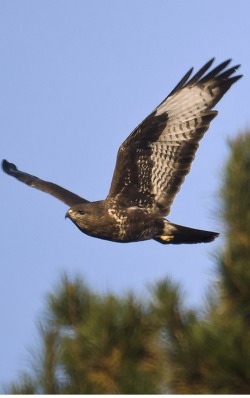 |
...New words every week; CLICK HERE for a full list Under construction: Lorem ipsum dolor sit amet, consectetuer adipiscing elit. Aenean commodo ligula eget dolor. Aenean massa. Cum sociis natoque penatibus et magnis dis parturient montes, nascetur ridiculus mus. Donec quam felis, ultricies nec, pellentesque eu, pretium quis, sem. |
 |
* |
* |
A B C D E F G H I J K L M N O P Q R S T U V W X Y Z CLICK for list of all the words
